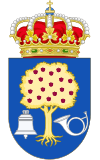Navalmoral de la Mata
| Navalmoral de la Mata | |||
|---|---|---|---|
| |||
 Navalmoral de la Mata Location in Spain. | |||
| Coordinates: ES 39°53′54″N 5°32′25″W / 39.89833°N 5.54028°WCoordinates: ES 39°53′54″N 5°32′25″W / 39.89833°N 5.54028°W | |||
| Autonomous community | Extremadura | ||
| Province | Cáceres | ||
| Comarca | Campo Arañuelo | ||
| Government | |||
| • Mayor | Raquel Medina | ||
| Area | |||
| • Total | 155.96 km2 (60.22 sq mi) | ||
| Elevation | 291 m (955 ft) | ||
| Population (2009) | |||
| • Total | 17,228 | ||
| • Density | 110/km2 (290/sq mi) | ||
| Time zone | CET (UTC+1) | ||
| • Summer (DST) | CEST (UTC+2) | ||
| Website | Official website | ||
Navalmoral de la Mata is a municipality located in the province of Cáceres, Extremadura, western Spain. In 2009, the municipality had a population of 17,228 inhabitants.
History
The area of Navalmoral includes remains from the Prehistoric and Roman (villas, bridges, temples etc.) ages. Navalmoral was founded in the late 14th - early 15th century as a communication hub. It became an autonomous commune in the 19th century.
In the first part of the 20th century, communications were improved, especially during Primo de Rivera's dictatorial regime and Second Republic regime. In those periods the La Vera and Guadalupe roads were constructed, as well as other less important roads.
In 1930 the Tobacco Fermentation Center (CNCFT) was built, boosting the economy of Navalmoral and its comarca. During the Spanish Civil War, Navalmoral joined the Republican cause, hoping to see change from an obsolete economic system mainly controlled by landowners. Navalmoral's economy grew after the war, based on agriculture, commerce, handicraft and services for all the comarca.
The Rosarito's Irrigation Plan had a remarkable impact on Navalmoral's economy and demography, notably it allowed the expansion of cotton and tobacco based local industries. Another public work of the 20th century was the construction of the Valdecañas Reservoir, which enabled exploition of the Tagus river, providing significant new funds for both Navalmoral town and its comarca, and thus helping to slow down the 1960s decline in population. Consequently, new districts and schools were built, available running water improved and thanks to the Tiétar river, sewers and other infrastructure improvements were made.
After a period of prosperity the economy began to stagnate, but in 1972 work on the Almaraz Nuclear Power Plant started, which boosted Navalmoral's population and economy again, even though there had been some local opposition to the project.
After the first democratic local polls in 1979 progress continued, thanks to a significant number of public works which enabled Navalmoral to become the main town in its comarca.
Culture
The main festival is the annual carnival, when for five days every early spring three large parades are held.
Economy
Navalmoral de la Mata is to be the base of "Expacio-Navalmoral", a logistical-industrial estate which will process, supply and deliver raw material and goods to major centres such as Madrid.

